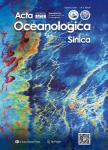Surface water exchanges in the Luzon Strait as inferred from Lagrangian coherent structures
Surface water exchanges in the Luzon Strait as inferred from Lagrangian coherent structures作者机构:State Key Laboratory of Marine Environmental ScienceCollege of Ocean and Earth SciencesXiamen UniversityXiamen 361102China Southern Marine Science and Engineering Guangdong Laboratory(Zhuhai)Zhuhai 519082China Joint Center for Ocean Remote SensingUniversity of Delaware-Xiamen UniversityNewarkDE 19716USA South China Sea Marine Survey and Technology CenterMinistry of Natural ResourcesGuangzhou 510300China
出 版 物:《Acta Oceanologica Sinica》 (海洋学报(英文版))
年 卷 期:2020年第39卷第11期
页 面:21-32页
核心收录:
学科分类:0710[理学-生物学] 0908[农学-水产] 07[理学] 0707[理学-海洋科学]
基 金:The National Key Research and Development Program of China under contract No.2016YFA0601201 the National Natural Science Foundation of China under contract Nos 91858202,91958203,41730533 and 41776003
主 题:Lagrangian coherent structures(LCSs) Kuroshio Luzon Strait transport pathways particle tracking
摘 要:This study presents a Lagrangian view of upper water exchanges across the Luzon Strait based on the finite-time Lyapunov exponents(FTLE)fields computed from the surface geostrophic *** Lagrangian coherent structures(LCSs)extracted from the FTLE fields well identify the typical flow patterns and eddy activities around the Luzon *** addition,they reveal the intricate transport paths and fluid domains,which are validated by the tracks of satellite-tracked surface drifters and cannot be visually recognized in the velocity *** FTLE fields indicate that there are mainly four types of transport patterns near the Luzon Strait;among them,the Kuroshio northward-flowingleapingpattern and the clockwise rotatingloopingpattern occur more frequently than theleakingpattern of the direct Kuroshio branch into the SCS and theoutflowingpattern from the SCS to the *** eddy shedding events of the Kuroshio at the Luzon Strait are further analyzed,and the importance of considering LCSs in estimating transport by eddies is *** anticyclonic eddy(ACE)shedding cases reveal that ACEs mainly originate from the looping paths of Kuroshio and thus could effectively trap the Kuroshio water before eddy *** provide useful information to predict the positions of the upstream waters that finally enter the *** contrast,LCS snapshots indicate that during the formation of cyclonic eddies(CEs),most CEs are not connected with the pathways of Kuroshio ***,the contribution of CEs to the surface water exchanges from the Pacific into the SCS is tiny.



